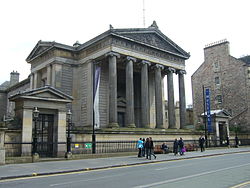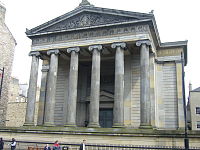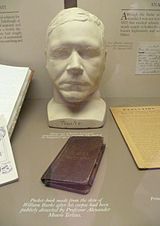Surgeons' Hall
| Surgeons' Hall | |
|
Midlothian | |
|---|---|
 Surgeons Hall Museum | |
| Location | |
| Grid reference: | NT26077326 |
| Location: | 55°56’48"N, 3°11’7"W |
| City: | Edinburgh |
| History | |
| Address: | Nicolson Street |
| Built 1697 | |
| By: | William Henry Playfair |
| Information | |
| Owned by: | The Royal College of Surgeons of Edinburgh |
| Website: | *www.rcsed.ac.uk |
Surgeons' Hall in Edinburgh, Midlothian, is the headquarters of the Royal College of Surgeons of Edinburgh. It also houses the Surgeons' Hall Museum, and the library and archive of the College.
The present Surgeons' Hall was designed by William Henry Playfair and completed in 1832, and is a Category A listed building.[1]
Surgeons' Hall Museum is Britain's the major medical museum, and one of Edinburgh's many tourist attractions. The museum is recognised as a collection of national significance.
History
The Royal College of Surgeons of Edinburgh was incorporated in 1505, when it received its Seal of Cause or charter as 'The Incorporation of Surgeons and Barbers of Edinburgh'.[2] The Museum at Surgeons Hall, Edinburgh dates from 1699 when the Incorporation announced that they were making a collection of 'natural and artificial curiosities'.[3] and advertised for these in the first edition of a local paper, the Edinburgh Gazette. Daniel Defoe, an early visitor in 1726, wrote in his Tour thro' the whole Island of Great Britain that the 'chamber of rarities' contained many curious things too numerous for him to describe. Much of this early collection was given to the University of Edinburgh in the 1760s.[3]
In the early 19th Century, the Incorporation received a Royal Charter to become the Royal College of Surgeons of Edinburgh. The College taught anatomy and surgery, and trained and examined surgeons. The museum in parallel expanded dramatically. Its collections were much too large to be housed in the original 1697 Surgeons' Hall, and so the surgeons commissioned the leading Edinburgh architect William Playfair to build the present day Surgeons Hall.
The new Surgeons' Hall opened in 1832.
At first the entire upper floor of the building was devoted to the museum collections, which were open to the public and attracted large visitor numbers. Throughout the 19th and early 20th century the collection expanded as it became customary for surgeons and pathologists to donate not only specimens which they regarded as interesting or instructive, but surgical instruments and equipment. With the great scientific and technical advances of the time, the museum began to acquire anaesthetic equipment, histology slides, X-rays and photographs.
At the start of the 20th century the College's need for a large meeting and ceremonial hall led to the conversion of about half of the museum space into what is now the main College hall. The 1907 minutes recorded the view that "it is essential to get rid of the Barclay collection which... has ceased to be of any value to the Fellows or to anyone visiting the museum." In the event, the retained Barclay collection was simply relocated, by the conversion and incorporation of an adjoining tenement building.
In February 2015, the College revealed their plans for a £1.5 million expansion which would provide a new conference and events centre. The expansion was achieved by the College taking over an adjacent three-floor building on Hill Place, which had formerly been a languages school.[4] this was opened in 2016 as the Prince Philip Building, named for the College's patron, Prince Philip, who became patron in 1955.
Museum collections
- The Charles Bell collection: donated by Charles Bell (born in Edinburgh in 1774, who practised in London and there amassed a museum of anatomical and pathology specimens which had grown to become one of the largest collections of its time. In 1825 he sold this collection to the Royal College of Surgeons of Edinburgh for £3,000. The Charles Bell Collection formed the heart of the Playfair Museum collection when the Playfair building opened in 1832, and much of it remains on display to this day.
- Charles Bell's Corunna oil paintings: a demonstration of his talent as an artist as well as a surgeon, Charles Bell produced a series of 15 oil paintings to illustrate the detail of the gunshots wounds suffered by the casualties of the Battle of Corunna, whom he treated in Portsmouth.
- The Barclay collection: donated by John Barclay (1758–1826), who had established an anatomy school in his house in 10 Surgeons' Square, next to the College and who became one of the most renowned anatomy teachers in Europe. His collection of some 2,500 specimens was donated to the museum, but by the 1950s most of this had been donated to other collections, leaving only an elephant skull, three human skeletons and a few other specimens.
- The Greig collection: a collection of some 250 skulls donated to the museum by David Middleton Greig (1864–1936), a surgeon in Dundee who was an international authority on bone disease and abnormalities of the skull, and who during his working life, had amassed a collection of some 200 skulls which he donated to the College.
- The Menzies Campbell collection: donated by John Menzies Campbell (1887–1974), a Glasgow dentist and dental historian who amassed over his working lifetime a huge personal collection of specimens, instruments and paintings relating to the practice of dentistry.[5]
- Casts and moulages: 19th and early 20th century wax and plaster casts or moulages showing abnormalities and diseases were widely used as teaching aids.
- William Burke: Burke and Hare murdered victims to supply the anatomy school in the 19th century, and while Hare turned King's evidence, Burke was hanged and his body was dissected at the college. The museum contains Burke's death mask and a pocket book made from his skin.[2]
- The Wohl pathology museum: pathology specimens, surgical instruments, casts and paintings.
Outside links
| ("Wikimedia Commons" has material about Surgeons' Hall) |
References
- ↑ "Surgeons' Hall". Historic Scotland. http://hsewsf.sedsh.gov.uk/pls/htmldb/f?p=2200:15:0::::BUILDING,HL:27772. Retrieved 20 September 2014.
- ↑ 2.0 2.1 Haertsch, Emilie (2017). "Auld Medicine". Distillations 2 (4): 46–47. https://www.sciencehistory.org/distillations/magazine/auld-medicine. Retrieved 23 March 2018.
- ↑ 3.0 3.1 Dingwall, H. M. (2005). 'A famous and flourishing society: the history of the Royal College of Surgeons of Edinburgh', 1505–2005 (Edinburgh University Press)
- ↑ King, Diane (28 February 2015). "Royal College of Surgeons' £1.5m for events centre". Edinburgh Evening News (Johnston Press). http://www.edinburghnews.scotsman.com/news/royal-college-of-surgeons-1-5m-for-events-centre-1-3704852. Retrieved 1 March 2015.
- ↑ Geissler, Paul. "A Glasgow Dentist, an Edinburgh Legacy". Henry Noble History of Dentistry Research Group. Archived from the original on 1 February 2013. https://web.archive.org/web/20130201191452/http://historyofdentistry.co.uk/index_htm_files/2001Oct2.pdf. Retrieved 20 September 2014.
Books
- Creswell, C. H.: 'The Royal College of Surgeons of Edinburgh: historical notes from 1505 to 1905' (Privately printed for the College by Oliver and Boyd, 1926)
- Comrie, J. D.: 'History of Scottish Medicine' (The Wellcome Historical Medical Museum, 1932)
- Tansey, V and Mekie, DEC: 'The Museum of the Royal College of Surgeons of Edinburgh (Royal College of Surgeons of Edinburgh, 1982)
- Masson A.H.B.: 'Portraits, paintings and busts in the Royal College of Surgeons of Edinburgh' (Royal College of Surgeons of Edinburgh, 1995)
- Masson A.H.B.: 'A College miscellany' (Royal College of Surgeons of Edinburgh, 2001)
- Macintyre, IMC; MacLaren I: 'Surgeons' Lives: Royal College of Surgeons of Edinburgh: an anthology of College Fellows over 500 years' (Royal College of Surgeons of Edinburgh, 2005) ISBN 978-0950362090
- Patrizio, A. and D. Kemp: 'Anatomy acts : how we come to know ourselves (Birlinn, 2006)
- Kemp, D., S. Barnes, et al. 'Surgeons' Hall: a museum anthology' (Royal College of Surgeons, 2009)
- Dingwall, HM; Hamilton D; Macintyre IMC; McCrae M; Wright D: 'Scottish Medicine – An Illustrated History' (Birlinn, 2011) ISBN 978-1780270180

